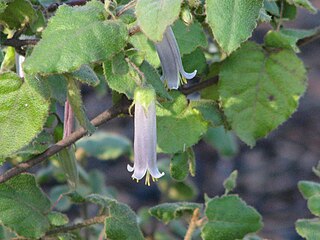
Correa aemula, commonly known as the hairy correa, is a species of shrub that is endemic to south-eastern Australia. It has broadly heart-shaped leaves arranged in opposite pairs, green or greyish green, pendent flowers arranged singly or in pairs and ageing to mauve-purple.

Leionema elatius, commonly known as tall phebalium, is a shrub species that is endemic to New South Wales and Queensland in Australia. It has glossy green, variably-shaped leaves and clusters of white-lemon flowers in spring.

Spathoglottis paulinae, commonly known as the small purple orchid, is a plant in the orchid family and is native to New Guinea and Tropical North Queensland. It is an evergreen terrestrial orchid with crowded pseudobulbs, between four and seven large, pleated leaves and up to thirty mauve to purple flowers.

Prostanthera prostantheroides is a plant in the family Lamiaceae and is endemic to Western Australia. It is a shrub with heart-shaped to round leaves and usually white flowers with purple spots inside the petal tube.

Pityrodia chrysocalyx is a flowering plant in the mint family Lamiaceae and is endemic to the south-west of Western Australia. It is an erect, bushy shrub with small, glossy leaves, and flowers with white petals and a golden-yellow calyx.
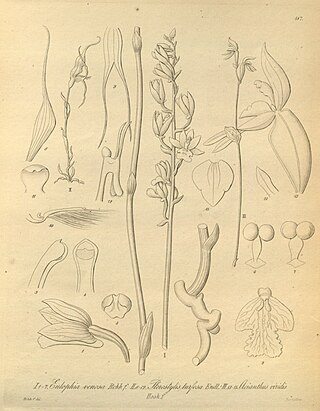
Eulophia venosa, commonly known as the pointed corduroy orchid, is a plant in the orchid family and is native to India, parts of Southeast Asia as well as New Guinea and northern Australia. It is a deciduous, terrestrial orchid with one large and one small leaf and between six and twenty pale green or yellowish flowers with purple markings. It grows in rainforest and grassy forests.

Dendrobium baileyi, commonly known as the blotched gemini orchid, is an epiphytic or lithophytic orchid in the family Orchidaceae and has arching stems and flowering stems with one or two spidery, yellow flowers with dark purple spots emerging from leaf axis. It grows in tropical North Queensland, New Guinea and the Solomon Islands.
Dendrobium fellowsii, commonly known as the native damsel orchid, is an epiphytic or lithophytic orchid in the family Orchidaceae and has upright pseudobulbs, up to five leaves and groups of up to five pale green or yellowish flowers with a deep purple labellum. It grows in tropical North Queensland.

Sarcochilus hillii, commonly known as myrtle bells, is a small epiphytic orchid native to eastern Australia and New Caledonia. It has up to ten drooping, quill-shaped leaves and up to ten frosty white or pink flowers that have a hairy labellum with purple stripes.
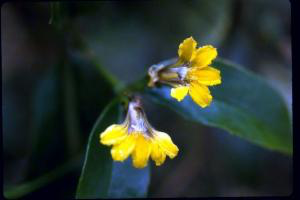
Scaevola enantophylla, commonly known as climbing fan-flower,is a species of flowering plant in the family Goodeniaceae and is endemic to Queensland. It is a scrambling vine with yellow fan-shaped flowers, and the only species in the genus with leaves arranged opposite.

Isopogon tridens, commonly known as the three-toothed coneflower, is a species of flowering plant in the family Proteaceae and is endemic to the southwest of Western Australia. It is a shrub with wedge-shaped leaves with two or three sharply-pointed teeth, and flattened-spherical heads of glabrous creamy white, sometimes purple flowers.

Rhadinothamnus euphemiae, is a slender, small, upright shrub with needle-shaped branchlets thickly covered with silvery scales and tubular greenish-purple tubular flowers throughout the year. It is endemic to the south coast of Western Australia.

Goodenia armitiana, commonly known as narrow-leaved goodenia or fine goodenia, is a species of flowering plant in the family Goodeniaceae and is endemic to northern Australia. It is an erect herb with sticky or vanished cylindrical leaves, racemes of yellow flowers with leaf-like bracts at the base, and more or less spherical fruit.

Goodenia microptera is a species of flowering plant in the family Goodeniaceae and is endemic to the Pilbara region of Western Australia. It is an erect to ascending, sprawling herb with narrow oblong to lance-shaped leaves sometimes with teeth on the edges, and racemes of yellow flowers with a brownish centre.
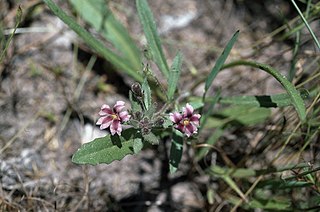
Goodenia purpurea is a species of flowering plant in the family Goodeniaceae and is endemic to the Northern Territory. It is an ascending herb with narrow oblong to lance-shaped leaves at the base of the plant, and racemes of purple flowers.

Atractocarpus hirtus, commonly known as the hairy gardenia or native loquat, is a plant in the madder family Rubiaceae, a large family of some 6,500 species with a cosmopolitan distribution. This species is endemic to northeastern Queensland, Australia.
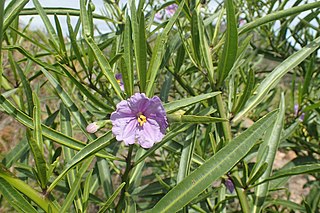
Solanum symonii is a species of flowering plant in the family Solanaceae and is native to near-coastal areas of Western Australia and South Australia. It is an erect shrub with egg-shaped to lance-shaped leaves and pale lavender-purple flowers.

Cryptandra longistaminea is a species of flowering plant in the family Rhamnaceae and is endemic to eastern Australia. It is a shrub with many branches, egg-shaped or elliptic to linear leaves, and clusters of white, tube-shaped flowers.

Androcalva melanopetala is a species of flowering plant in the family Malvaceae and is endemic to southern inland Western Australia. It is a sometimes prostrate shrub that has densely hairy new growth, egg-shaped to elliptic leaves with rounded teeth on the edges, and clusters of white or cream-coloured and pink to red flowers.
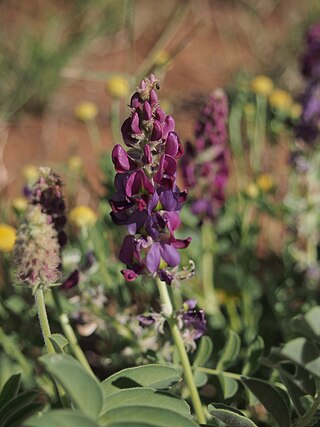
Swainsona canescens, commonly known as grey swainsona, is a flowering plant in the family Fabaceae. It is a small perennial herb with pink-purple or purple, yellow and green flowers and grows in Queensland, Western Australia and South Australia.



















